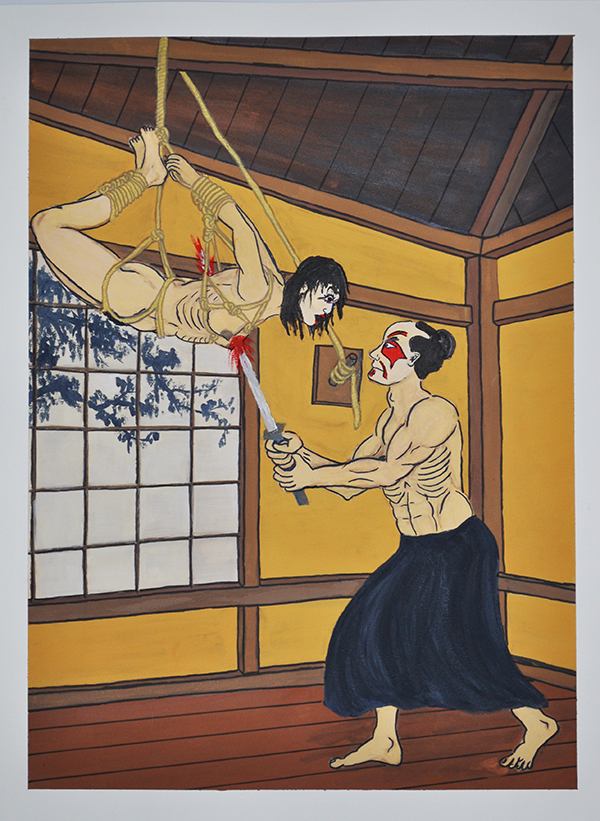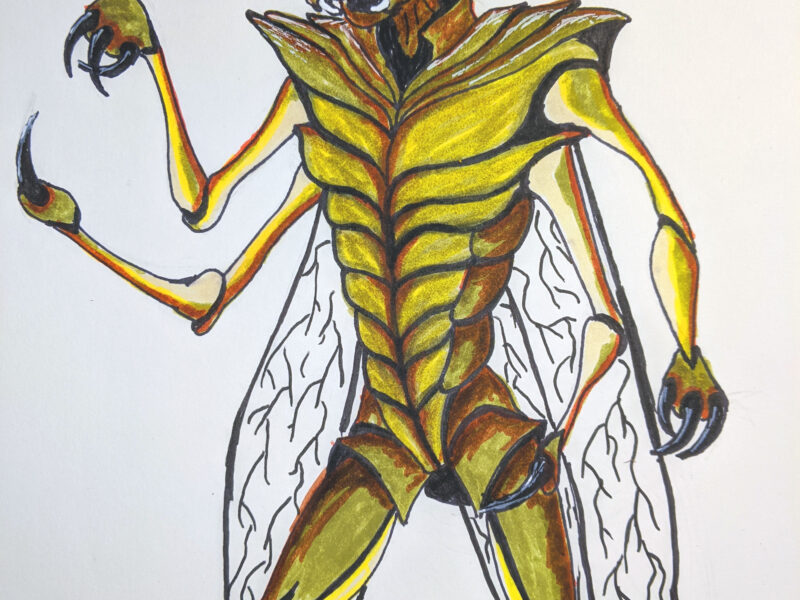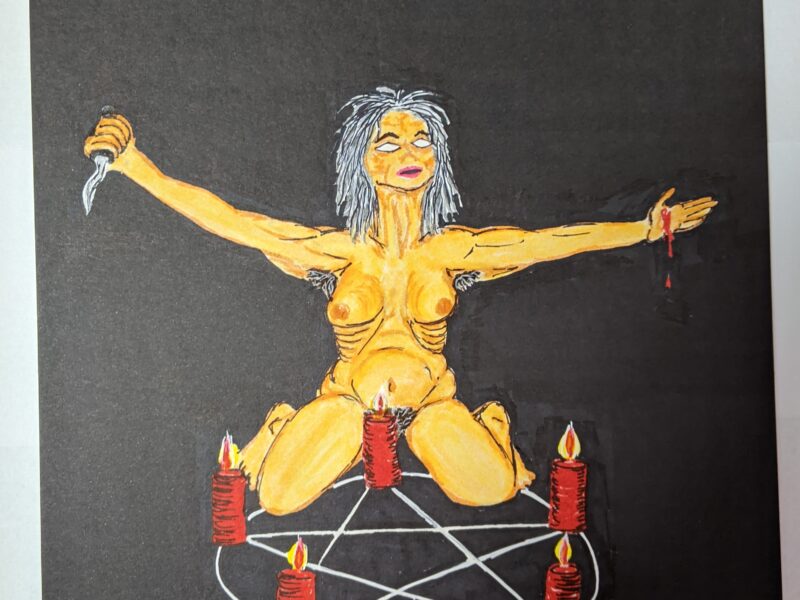This 18×24 gouache painting is another I did in my series honoring the Ukiyo E style. The scene was inspired by a wood block print done by Tsukioka Yoshitoshi in his series titled “28 famous murders”. I made a point to put the victim in different poses in my work so as not to sully the beauty of his blocks with my clumsy interpretation.
My selected title refers to my dark sense of humor. (how many don’t). The thought driving it is the irony of how modern humans, and especially Americans fetishize a great number of historical torture methods, and even means of execution. This is especially true when it comes to BDSM in general, but most especially Shibari. That said, nothing wrong with them. Kind of a fan myself, but man people are weird. Or at least I am.
Here is some background on the original works if you have interest in Ukiyo E.
Tsukioka Yoshitoshi (1839-1892) was a renowned Japanese artist of the late Edo and early Meiji periods, widely celebrated for his mastery in ukiyo-e woodblock printing. His work is distinguished by its vivid and dynamic depictions of historical, mythological, and supernatural themes, often imbued with a sense of drama and psychological depth.
Background and Artistic Development
- Early Life and Training: Yoshitoshi was born in Edo (now Tokyo) and began his artistic training under the famous ukiyo-e master, Utagawa Kuniyoshi, at the age of 11. Kuniyoshi’s influence is evident in Yoshitoshi’s work, particularly in his skillful rendering of dramatic scenes and his focus on historical subjects.
- Artistic Style: Yoshitoshi’s style evolved throughout his career, reflecting the tumultuous changes in Japanese society as it transitioned from the Edo period to the Meiji era. His work often juxtaposed traditional Japanese aesthetics with elements of Western art, which was becoming increasingly influential in Japan at the time.
Woodblock Printing
Woodblock printing, or ukiyo-e, was a popular art form in Japan from the 17th to the 19th centuries. Artists like Yoshitoshi would create detailed designs, which were then carved into wooden blocks, inked, and pressed onto paper. This method allowed for the mass production of artworks, making them accessible to a broader audience.
Technical Mastery
- Line Work and Detail: Yoshitoshi was known for his precise and intricate line work, which brought a remarkable level of detail and texture to his prints.
- Color and Composition: He employed bold colors and innovative compositions, often using strong contrasts and dynamic perspectives to heighten the emotional impact of his scenes.
- Themes: His subjects ranged from historical battles and legendary heroes to ghost stories and scenes of contemporary life, always with a keen eye for human emotion and psychological nuance.
“28 Famous Murders with Verses” (Eimei Nijūhasshūku)
One of Yoshitoshi’s most famous and controversial series is “Eimei Nijūhasshūku” (英名二十八衆句), often translated as “28 Famous Murders with Verses.” This series, created in the early 1860s, consists of 28 woodblock prints depicting notorious murders and acts of violence from Japanese history and legend.
Description of the Series
- Historical and Mythological Sources: The series draws from a wide range of sources, including historical events, kabuki theater, and popular folklore. Each print typically features a dramatic and often gruesome scene of a murder or violent act.
- Accompanying Verses: Each print is accompanied by a verse or short poem, often adding a layer of moral reflection or literary context to the depicted scene.
- Artistic Techniques: The prints are notable for their intense emotional expressions, meticulous detail, and dynamic compositions. Yoshitoshi used a stark and sometimes jarring contrast of colors to enhance the sense of drama and horror.
Notable Prints in the Series
- The Death of the Soga Brothers: This print depicts the dramatic and tragic end of the Soga brothers, famous for their vendetta against the killer of their father.
- The Ghost of Kohada Koheiji: A haunting scene showing the ghost of Kohada Koheiji seeking revenge against his treacherous wife and her lover.
- The Murder of Oiwa: Based on the kabuki play “Yotsuya Kaidan,” this print captures the moment of Oiwa’s murder, one of the most famous ghost stories in Japan.
Impact and Legacy
- Controversy: Due to the graphic nature of the series, it faced criticism and was seen as sensationalist by some contemporaries. However, it also garnered significant attention and acclaim for its bold and innovative approach to storytelling and visual art.
- Influence: Yoshitoshi’s work, particularly the “28 Famous Murders,” has had a lasting impact on Japanese art and culture. It has been studied and admired for its technical mastery, emotional depth, and its exploration of the darker aspects of human nature.
- Cultural Reflection: The series reflects the social and cultural anxieties of a rapidly changing Japan, grappling with the tensions between tradition and modernization.
Conclusion
Tsukioka Yoshitoshi remains a pivotal figure in the history of Japanese art, celebrated for his contributions to the ukiyo-e tradition and his ability to capture the complexity of human emotions through his prints. The “28 Famous Murders with Verses” stands out as a testament to his artistic brilliance and his willingness to push the boundaries of his medium to explore the darker facets of the human experience.



